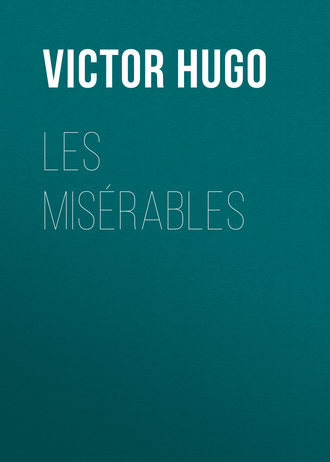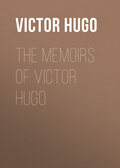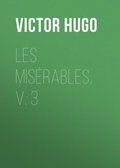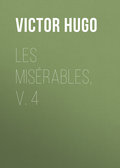
Виктор Мари Гюго
Les Misérables
BOOK FIFTH. – FOR A BLACK HUNT, A MUTE PACK
CHAPTER I – THE ZIGZAGS OF STRATEGY
An observation here becomes necessary, in view of the pages which the reader is about to peruse, and of others which will be met with further on.
The author of this book, who regrets the necessity of mentioning himself, has been absent from Paris for many years. Paris has been transformed since he quitted it. A new city has arisen, which is, after a fashion, unknown to him. There is no need for him to say that he loves Paris: Paris is his mind’s natal city. In consequence of demolitions and reconstructions, the Paris of his youth, that Paris which he bore away religiously in his memory, is now a Paris of days gone by. He must be permitted to speak of that Paris as though it still existed. It is possible that when the author conducts his readers to a spot and says, “In such a street there stands such and such a house,” neither street nor house will any longer exist in that locality. Readers may verify the facts if they care to take the trouble. For his own part, he is unacquainted with the new Paris, and he writes with the old Paris before his eyes in an illusion which is precious to him. It is a delight to him to dream that there still lingers behind him something of that which he beheld when he was in his own country, and that all has not vanished. So long as you go and come in your native land, you imagine that those streets are a matter of indifference to you; that those windows, those roofs, and those doors are nothing to you; that those walls are strangers to you; that those trees are merely the first encountered haphazard; that those houses, which you do not enter, are useless to you; that the pavements which you tread are merely stones. Later on, when you are no longer there, you perceive that the streets are dear to you; that you miss those roofs, those doors; and that those walls are necessary to you, those trees are well beloved by you; that you entered those houses which you never entered, every day, and that you have left a part of your heart, of your blood, of your soul, in those pavements. All those places which you no longer behold, which you may never behold again, perchance, and whose memory you have cherished, take on a melancholy charm, recur to your mind with the melancholy of an apparition, make the holy land visible to you, and are, so to speak, the very form of France, and you love them; and you call them up as they are, as they were, and you persist in this, and you will submit to no change: for you are attached to the figure of your fatherland as to the face of your mother.
May we, then, be permitted to speak of the past in the present? That said, we beg the reader to take note of it, and we continue.
Jean Valjean instantly quitted the boulevard and plunged into the streets, taking the most intricate lines which he could devise, returning on his track at times, to make sure that he was not being followed.
This manœuvre is peculiar to the hunted stag. On soil where an imprint of the track may be left, this manœuvre possesses, among other advantages, that of deceiving the huntsmen and the dogs, by throwing them on the wrong scent. In venery this is called false re-imbushment.
The moon was full that night. Jean Valjean was not sorry for this. The moon, still very close to the horizon, cast great masses of light and shadow in the streets. Jean Valjean could glide along close to the houses on the dark side, and yet keep watch on the light side. He did not, perhaps, take sufficiently into consideration the fact that the dark side escaped him. Still, in the deserted lanes which lie near the Rue Poliveau, he thought he felt certain that no one was following him.
Cosette walked on without asking any questions. The sufferings of the first six years of her life had instilled something passive into her nature. Moreover, – and this is a remark to which we shall frequently have occasion to recur, – she had grown used, without being herself aware of it, to the peculiarities of this good man and to the freaks of destiny. And then she was with him, and she felt safe.
Jean Valjean knew no more where he was going than did Cosette. He trusted in God, as she trusted in him. It seemed as though he also were clinging to the hand of some one greater than himself; he thought he felt a being leading him, though invisible. However, he had no settled idea, no plan, no project. He was not even absolutely sure that it was Javert, and then it might have been Javert, without Javert knowing that he was Jean Valjean. Was not he disguised? Was not he believed to be dead? Still, queer things had been going on for several days. He wanted no more of them. He was determined not to return to the Gorbeau house. Like the wild animal chased from its lair, he was seeking a hole in which he might hide until he could find one where he might dwell.
Jean Valjean described many and varied labyrinths in the Mouffetard quarter, which was already asleep, as though the discipline of the Middle Ages and the yoke of the curfew still existed; he combined in various manners, with cunning strategy, the Rue Censier and the Rue Copeau, the Rue du Battoir-Saint-Victor and the Rue du Puits l’Ermite. There are lodging houses in this locality, but he did not even enter one, finding nothing which suited him. He had no doubt that if any one had chanced to be upon his track, they would have lost it.
As eleven o’clock struck from Saint-Étienne-du-Mont, he was traversing the Rue de Pontoise, in front of the office of the commissary of police, situated at No. 14. A few moments later, the instinct of which we have spoken above made him turn round. At that moment he saw distinctly, thanks to the commissary’s lantern, which betrayed them, three men who were following him closely, pass, one after the other, under that lantern, on the dark side of the street. One of the three entered the alley leading to the commissary’s house. The one who marched at their head struck him as decidedly suspicious.
“Come, child,” he said to Cosette; and he made haste to quit the Rue Pontoise.
He took a circuit, turned into the Passage des Patriarches, which was closed on account of the hour, strode along the Rue de l‘Épée-de-Bois and the Rue de l’Arbalète, and plunged into the Rue des Postes.
At that time there was a square formed by the intersection of streets, where the College Rollin stands to-day, and where the Rue Neuve-Sainte-Geneviève turns off.
It is understood, of course, that the Rue Neuve-Sainte-Geneviève is an old street, and that a posting-chaise does not pass through the Rue des Postes once in ten years. In the thirteenth century this Rue des Postes was inhabited by potters, and its real name is Rue des Pots.
The moon cast a livid light into this open space. Jean Valjean went into ambush in a doorway, calculating that if the men were still following him, he could not fail to get a good look at them, as they traversed this illuminated space.
In point of fact, three minutes had not elapsed when the men made their appearance. There were four of them now. All were tall, dressed in long, brown coats, with round hats, and huge cudgels in their hands. Their great stature and their vast fists rendered them no less alarming than did their sinister stride through the darkness. One would have pronounced them four spectres disguised as bourgeois.
They halted in the middle of the space and formed a group, like men in consultation. They had an air of indecision. The one who appeared to be their leader turned round and pointed hastily with his right hand in the direction which Jean Valjean had taken; another seemed to indicate the contrary direction with considerable obstinacy. At the moment when the first man wheeled round, the moon fell full in his face. Jean Valjean recognized Javert perfectly.
CHAPTER II – IT IS LUCKY THAT THE PONT D’AUSTERLITZ BEARS CARRIAGES
Uncertainty was at an end for Jean Valjean: fortunately it still lasted for the men. He took advantage of their hesitation. It was time lost for them, but gained for him. He slipped from under the gate where he had concealed himself, and went down the Rue des Postes, towards the region of the Jardin des Plantes. Cosette was beginning to be tired. He took her in his arms and carried her. There were no passers-by, and the street lanterns had not been lighted on account of there being a moon.
He redoubled his pace.
In a few strides he had reached the Goblet potteries, on the front of which the moonlight rendered distinctly legible the ancient inscription: —
De Goblet fils c’est ici la fabrique;
Venez choisir des cruches et des brocs,
Des pots à fleurs, des tuyaux, de la brique.
A tout venant le Cœur vend des Carreaux.14
He left behind him the Rue de la Clef, then the Fountain Saint-Victor, skirted the Jardin des Plantes by the lower streets, and reached the quay. There he turned round. The quay was deserted. The streets were deserted. There was no one behind him. He drew a long breath.
He gained the Pont d’Austerlitz.
Tolls were still collected there at that epoch.
He presented himself at the toll office and handed over a sou.
“It is two sous,” said the old soldier in charge of the bridge. “You are carrying a child who can walk. Pay for two.”
He paid, vexed that his passage should have aroused remark. Every flight should be an imperceptible slipping away.
A heavy cart was crossing the Seine at the same time as himself, and on its way, like him, to the right bank. This was of use to him. He could traverse the bridge in the shadow of the cart.
Towards the middle of the Bridge, Cosette, whose feet were benumbed, wanted to walk. He set her on the ground and took her hand again.
The bridge once crossed, he perceived some timber-yards on his right. He directed his course thither. In order to reach them, it was necessary to risk himself in a tolerably large unsheltered and illuminated space. He did not hesitate. Those who were on his track had evidently lost the scent, and Jean Valjean believed himself to be out of danger. Hunted, yes; followed, no.
A little street, the Rue du Chemin-Vert-Saint-Antoine, opened out between two timber-yards enclosed in walls. This street was dark and narrow and seemed made expressly for him. Before entering it he cast a glance behind him.
From the point where he stood he could see the whole extent of the Pont d’Austerlitz.
Four shadows were just entering on the bridge.
These shadows had their backs turned to the Jardin des Plantes and were on their way to the right bank.
These four shadows were the four men.
Jean Valjean shuddered like the wild beast which is recaptured.
One hope remained to him; it was, that the men had not, perhaps, stepped on the bridge, and had not caught sight of him while he was crossing the large illuminated space, holding Cosette by the hand.
In that case, by plunging into the little street before him, he might escape, if he could reach the timber-yards, the marshes, the market-gardens, the uninhabited ground which was not built upon.
It seemed to him that he might commit himself to that silent little street. He entered it.
CHAPTER III – TO WIT, THE PLAN OF PARIS IN 1727
Three hundred paces further on, he arrived at a point where the street forked. It separated into two streets, which ran in a slanting line, one to the right, and the other to the left.
Jean Valjean had before him what resembled the two branches of a Y. Which should he choose? He did not hesitate, but took the one on the right.
Why?
Because that to the left ran towards a suburb, that is to say, towards inhabited regions, and the right branch towards the open country, that is to say, towards deserted regions.
However, they no longer walked very fast. Cosette’s pace retarded Jean Valjean’s.
He took her up and carried her again. Cosette laid her head on the shoulder of the good man and said not a word.
He turned round from time to time and looked behind him. He took care to keep always on the dark side of the street. The street was straight in his rear. The first two or three times that he turned round he saw nothing; the silence was profound, and he continued his march somewhat reassured. All at once, on turning round, he thought he perceived in the portion of the street which he had just passed through, far off in the obscurity, something which was moving.
He rushed forward precipitately rather than walked, hoping to find some side-street, to make his escape through it, and thus to break his scent once more.
He arrived at a wall.
This wall, however, did not absolutely prevent further progress; it was a wall which bordered a transverse street, in which the one he had taken ended.
Here again, he was obliged to come to a decision; should he go to the right or to the left.
He glanced to the right. The fragmentary lane was prolonged between buildings which were either sheds or barns, then ended at a blind alley. The extremity of the cul-de-sac was distinctly visible, – a lofty white wall.
He glanced to the left. On that side the lane was open, and about two hundred paces further on, ran into a street of which it was the affluent. On that side lay safety.
At the moment when Jean Valjean was meditating a turn to the left, in an effort to reach the street which he saw at the end of the lane, he perceived a sort of motionless, black statue at the corner of the lane and the street towards which he was on the point of directing his steps.
It was some one, a man, who had evidently just been posted there, and who was barring the passage and waiting.
Jean Valjean recoiled.
The point of Paris where Jean Valjean found himself, situated between the Faubourg Saint-Antoine and la Râpée, is one of those which recent improvements have transformed from top to bottom, – resulting in disfigurement according to some, and in a transfiguration according to others. The market-gardens, the timber-yards, and the old buildings have been effaced. To-day, there are brand-new, wide streets, arenas, circuses, hippodromes, railway stations, and a prison, Mazas, there; progress, as the reader sees, with its antidote.
Half a century ago, in that ordinary, popular tongue, which is all compounded of traditions, which persists in calling the Institut les Quatre-Nations, and the Opera-Comique Feydeau, the precise spot whither Jean Valjean had arrived was called le Petit-Picpus. The Porte Saint-Jacques, the Porte Paris, the Barrière des Sergents, the Porcherons, la Galiote, les Célestins, les Capucins, le Mail, la Bourbe, l’Arbre de Cracovie, la Petite-Pologne – these are the names of old Paris which survive amid the new. The memory of the populace hovers over these relics of the past.
Le Petit-Picpus, which, moreover, hardly ever had any existence, and never was more than the outline of a quarter, had nearly the monkish aspect of a Spanish town. The roads were not much paved; the streets were not much built up. With the exception of the two or three streets, of which we shall presently speak, all was wall and solitude there. Not a shop, not a vehicle, hardly a candle lighted here and there in the windows; all lights extinguished after ten o’clock. Gardens, convents, timber-yards, marshes; occasional lowly dwellings and great walls as high as the houses.
Such was this quarter in the last century. The Revolution snubbed it soundly. The republican government demolished and cut through it. Rubbish shoots were established there. Thirty years ago, this quarter was disappearing under the erasing process of new buildings. To-day, it has been utterly blotted out. The Petit-Picpus, of which no existing plan has preserved a trace, is indicated with sufficient clearness in the plan of 1727, published at Paris by Denis Thierry, Rue Saint-Jacques, opposite the Rue du Plâtre; and at Lyons, by Jean Girin, Rue Mercière, at the sign of Prudence. Petit-Picpus had, as we have just mentioned, a Y of streets, formed by the Rue du Chemin-Vert-Saint-Antoine, which spread out in two branches, taking on the left the name of Little Picpus Street, and on the right the name of the Rue Polonceau. The two limbs of the Y were connected at the apex as by a bar; this bar was called Rue Droit-Mur. The Rue Polonceau ended there; Rue Petit-Picpus passed on, and ascended towards the Lenoir market. A person coming from the Seine reached the extremity of the Rue Polonceau, and had on his right the Rue Droit-Mur, turning abruptly at a right angle, in front of him the wall of that street, and on his right a truncated prolongation of the Rue Droit-Mur, which had no issue and was called the Cul-de-Sac Genrot.
It was here that Jean Valjean stood.
As we have just said, on catching sight of that black silhouette standing on guard at the angle of the Rue Droit-Mur and the Rue Petit-Picpus, he recoiled. There could be no doubt of it. That phantom was lying in wait for him.
What was he to do?
The time for retreating was passed. That which he had perceived in movement an instant before, in the distant darkness, was Javert and his squad without a doubt. Javert was probably already at the commencement of the street at whose end Jean Valjean stood. Javert, to all appearances, was acquainted with this little labyrinth, and had taken his precautions by sending one of his men to guard the exit. These surmises, which so closely resembled proofs, whirled suddenly, like a handful of dust caught up by an unexpected gust of wind, through Jean Valjean’s mournful brain. He examined the Cul-de-Sac Genrot; there he was cut off. He examined the Rue Petit-Picpus; there stood a sentinel. He saw that black form standing out in relief against the white pavement, illuminated by the moon; to advance was to fall into this man’s hands; to retreat was to fling himself into Javert’s arms. Jean Valjean felt himself caught, as in a net, which was slowly contracting; he gazed heavenward in despair.
CHAPTER IV – THE GROPINGS OF FLIGHT
In order to understand what follows, it is requisite to form an exact idea of the Droit-Mur lane, and, in particular, of the angle which one leaves on the left when one emerges from the Rue Polonceau into this lane. Droit-Mur lane was almost entirely bordered on the right, as far as the Rue Petit-Picpus, by houses of mean aspect; on the left by a solitary building of severe outlines, composed of numerous parts which grew gradually higher by a story or two as they approached the Rue Petit-Picpus side; so that this building, which was very lofty on the Rue Petit-Picpus side, was tolerably low on the side adjoining the Rue Polonceau. There, at the angle of which we have spoken, it descended to such a degree that it consisted of merely a wall. This wall did not abut directly on the street; it formed a deeply retreating niche, concealed by its two corners from two observers who might have been, one in the Rue Polonceau, the other in the Rue Droit-Mur.
Beginning with these angles of the niche, the wall extended along the Rue Polonceau as far as a house which bore the number 49, and along the Rue Droit-Mur, where the fragment was much shorter, as far as the gloomy building which we have mentioned and whose gable it intersected, thus forming another retreating angle in the street. This gable was sombre of aspect; only one window was visible, or, to speak more correctly, two shutters covered with a sheet of zinc and kept constantly closed.
The state of the places of which we are here giving a description is rigorously exact, and will certainly awaken a very precise memory in the mind of old inhabitants of the quarter.
The niche was entirely filled by a thing which resembled a colossal and wretched door; it was a vast, formless assemblage of perpendicular planks, the upper ones being broader than the lower, bound together by long transverse strips of iron. At one side there was a carriage gate of the ordinary dimensions, and which had evidently not been cut more than fifty years previously.
A linden-tree showed its crest above the niche, and the wall was covered with ivy on the side of the Rue Polonceau.
In the imminent peril in which Jean Valjean found himself, this sombre building had about it a solitary and uninhabited look which tempted him. He ran his eyes rapidly over it; he said to himself, that if he could contrive to get inside it, he might save himself. First he conceived an idea, then a hope.
In the central portion of the front of this building, on the Rue Droit-Mur side, there were at all the windows of the different stories ancient cistern pipes of lead. The various branches of the pipes which led from one central pipe to all these little basins sketched out a sort of tree on the front. These ramifications of pipes with their hundred elbows imitated those old leafless vine-stocks which writhe over the fronts of old farm-houses.
This odd espalier, with its branches of lead and iron, was the first thing that struck Jean Valjean. He seated Cosette with her back against a stone post, with an injunction to be silent, and ran to the spot where the conduit touched the pavement. Perhaps there was some way of climbing up by it and entering the house. But the pipe was dilapidated and past service, and hardly hung to its fastenings. Moreover, all the windows of this silent dwelling were grated with heavy iron bars, even the attic windows in the roof. And then, the moon fell full upon that façade, and the man who was watching at the corner of the street would have seen Jean Valjean in the act of climbing. And finally, what was to be done with Cosette? How was she to be drawn up to the top of a three-story house?
He gave up all idea of climbing by means of the drain-pipe, and crawled along the wall to get back into the Rue Polonceau.
When he reached the slant of the wall where he had left Cosette, he noticed that no one could see him there. As we have just explained, he was concealed from all eyes, no matter from which direction they were approaching; besides this, he was in the shadow. Finally, there were two doors; perhaps they might be forced. The wall above which he saw the linden-tree and the ivy evidently abutted on a garden where he could, at least, hide himself, although there were as yet no leaves on the trees, and spend the remainder of the night.
Time was passing; he must act quickly.
He felt over the carriage door, and immediately recognized the fact that it was impracticable outside and in.
He approached the other door with more hope; it was frightfully decrepit; its very immensity rendered it less solid; the planks were rotten; the iron bands – there were only three of them – were rusted. It seemed as though it might be possible to pierce this worm-eaten barrier.
On examining it he found that the door was not a door; it had neither hinges, cross-bars, lock, nor fissure in the middle; the iron bands traversed it from side to side without any break. Through the crevices in the planks he caught a view of unhewn slabs and blocks of stone roughly cemented together, which passers-by might still have seen there ten years ago. He was forced to acknowledge with consternation that this apparent door was simply the wooden decoration of a building against which it was placed. It was easy to tear off a plank; but then, one found one’s self face to face with a wall.







